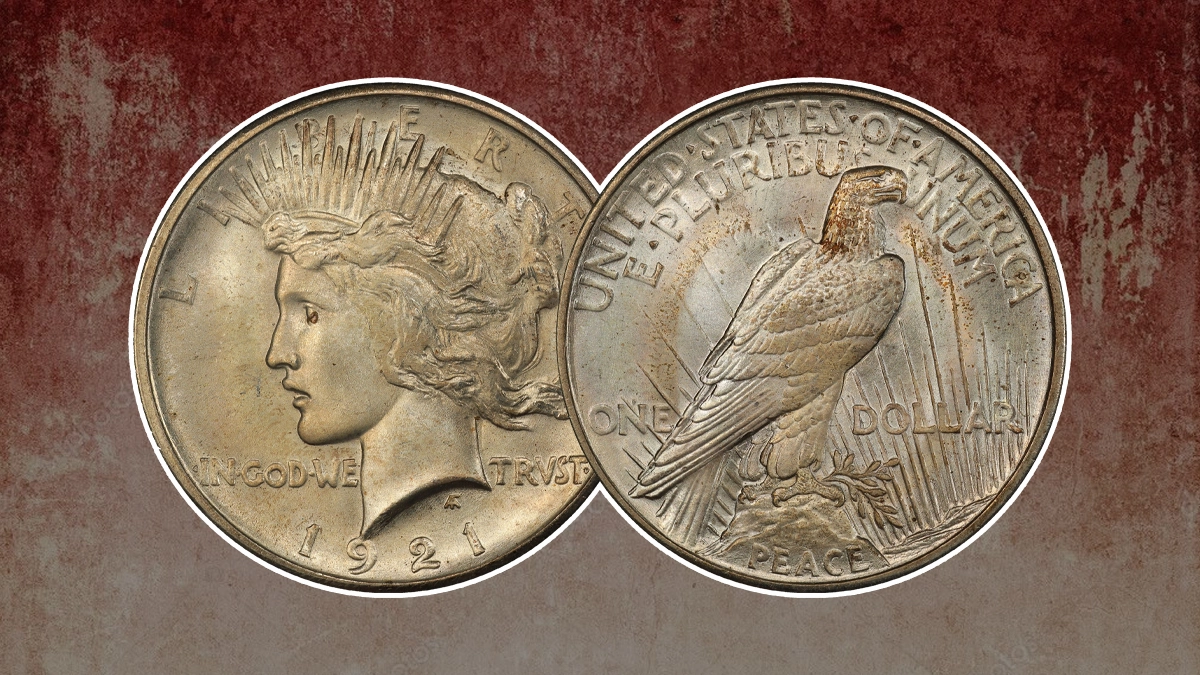
The 1921 High Relief Peace Dollar holds a special place in numismatic history as the inaugural issue of its series. It was designed by Anthony de Francisci, this coin was crafted during a time of national optimism and recovery following World War I. Its unique high-relief design, reminiscent of the Saint-Gaudens Double Eagle, posed initial striking challenges at the Philadelphia Mint.
This coin is celebrated not only for its symbolic expression of peace but also for its lack and striking intricacies. Many examples show weakness in the central details of Liberty’s hair and the eagle’s feathers, a result of the high-relief design. Despite these challenges, well-struck Gem examples with frosty white luster or satiny finishes are highly coveted among collectors.
Toning, ranging from light golden hues to heavy patina, is common on the 1921 Peace Dollar, though any vibrant rainbow colors are usually considered artificially enhanced. This coin’s continuing allure and historical significance make it a prized possession for collectors and enthusiasts alike, displaying the artistry and heritage of early 20th-century American coinage.
Specification:
Designer: Anthony de Francisci
Edge: Reeded
Diameter: 38.10 millimeters
Weight: 26.73 grams
Mintage: 1,006,473
Mint: Philadelphia
Metal: 90% Silver, 10% Copper
Auction Record: $132,000 • MS67 • 08-22-2018 • Stack’s Bowers
Design:
At the end of World War I, Americans wanted a silver dollar commemorating the end of the war. The winning and beautiful design belonged to artist Anthony De Francisci, who sported the obverse figure after his wife, Teresa.
- Anyone gathering U.S. silver dollars.
- ONLY high-relief silver to circulate in the U.S.
- The only official U.S. coin marking peace with the ending of WWI
- Millions of becoming scarce silver were melted down when its price went up to more than $50 per ounce in the 1980s.
- Certified to be in Extra Fine condition*
Obverse:
Many people have concerns about the spelling of the word “TRVST” on the obverse side. It is because of the formation of the letter “V” in the position of “U”. According to mimic Latin, a familiar stylistic selection of the time. The letter “V” is identical to the English letter “U” in Latin, so, many people think the “V” stands for “victory”. Some people think of it as the hand symbol for peace, which utilizes one’s index and lead fingers.
Reverse:
The reverse side of the coin shows a bald eagle sitting perched on a mountaintop as it protects the sun over a new world. The eagle has an olive branch in its grip, which is a sign of peace.
1921 Peace Dollar Value
All the 1921 Peace dollars were circulating within a few years of the problem. This dollar was struck in a higher relief at the Philadelphia Mint on both the obverse and reverse than in later years. The first Peace dollars minted in late December 1921 were rushed, resulting in a few sharply struck coins due to limited press testing.
Approximately 1% of these coins, graded MS-63 to MS-65, exhibit sharp details. Higher Mint State examples often have good luster but may show weakness at the center of the obverse. Coins stored in bank bags may display yellow, yellow-gray, or black toning. The designer’s monogram, Anthony de Francisci’s initials, is below Lady Liberty’s neck on the coin’s field.
According to the NGC Price Guide, a Peace Dollar from 1921 in the circulated condition is worth between $100 and $525 as of July 2024. However, 1921 PEACE Silver Dollars in pristine, uncirculated condition sell for as much as $67500 on the open market.
Availability in Mint State Grades:
The 1921 Peace dollars are commonly found in circulated conditions such as EF (Extremely Fine) and AU (About Uncirculated), with fewer examples in lower grades like Fine to VF (Very Fine). These circulated coins typically do not carry a significant premium above their silver value.
In Mint State grades (MS-60 to MS-65), the 1921 High Relief Peace dollar is readily available, and occasionally found in higher grades. This makes it accessible for collectors on various budgets. Collectors should pay attention to the sharpness of the strike, particularly noting the hair details near Liberty’s ear. Coins with good luster and light toning, often with golden hues, are sought after.
The obverse of the Peace Dollar features a bust of Liberty facing left, adorned with a pointed crown and flowing hair, with the inscriptions “Liberty,” “In God We Trust,” and “1921.” The reverse displays an eagle perched on a rock with rays in the background, surrounded by the inscriptions “The United States of America,” “E Pluribus Unum,” “One Dollar,” and “Peace.”
The Peace Dollar series is highly popular among collectors. If you’re considering selling a Peace Dollar, expert assistance is available through platforms like Coinappraiser.com, which also offers rare coin auctions and online price guides for valuation.
Also Read – 1919 Walking Liberty Half Dollar: A Comprehensive Guide
Conclusion:
The 1921 High Relief Peace Dollar is an important piece in American numismatic history, marking the inception of a series designed to symbolize peace after World War I. Designed by Anthony de Francisci, this coin’s high relief posed initial striking challenges, resulting in a limited number of sharply struck examples.
Despite variations in striking quality, well-preserved specimens in Mint State grades remain accessible to collectors, offering opportunities to acquire pieces with desirable luster and toning. With its enduring popularity and historical significance, the 1921 Peace Dollar continues to captivate numismatists, embodying both artistic excellence and the cultural spirit of its era.
